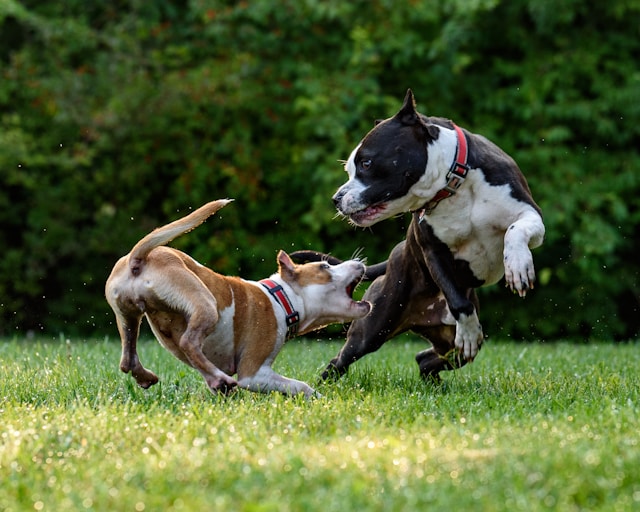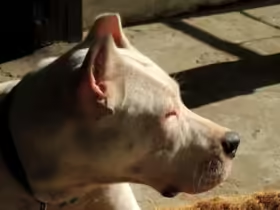Manage aggression in dogs using effective strategies . Aggressive behavior in dogs can be challenging and concerning for pet owners. Whether it manifests as growling, snapping, or biting, addressing aggression is crucial for maintaining a safe and harmonious household. Understanding the underlying causes of aggression and implementing effective strategies can help manage and reduce these behaviors. This comprehensive guide explores the reasons behind dog aggression and offers practical solutions to foster a more peaceful environment for both you and your dog.
1. Understanding Dog Aggression
Before addressing aggressive behavior, it’s essential to understand its potential causes. Aggression in dogs can stem from various sources, including:
1.1. Fear and Anxiety
Fear-based aggression occurs when a dog feels threatened or scared. For instance, a dog may become aggressive if they are cornered or approached too suddenly. Moreover, dogs with a history of trauma or abuse may exhibit fear-based aggression as a defensive mechanism.
1.2. Territorial Behavior
Territorial aggression happens when a dog perceives a threat to their space or possessions. For example, a dog may growl or snap when someone enters their home or approaches their food bowl. Additionally, this behavior can be directed towards other pets or people.
1.3. Resource Guarding
Resource guarding involves aggressive behavior when a dog protects valued resources such as food, toys, or even people. In particular, a dog may become aggressive if they feel their resources are being threatened or taken away.
1.4. Pain or Illness
Pain-induced aggression occurs when a dog is in discomfort or suffering from an illness. For instance, a dog with an injury or a medical condition may become irritable and defensive. Therefore, it’s crucial to consider whether pain or health issues might be contributing to aggressive behavior.
1.5. Lack of Socialization
Poor socialization can lead to aggression, especially if a dog is not accustomed to various people, animals, or environments. In fact, dogs that have not been exposed to different stimuli may react aggressively out of fear or confusion.
2. Assessing the Situation
To address aggressive behavior effectively, you first need to assess the situation and identify the triggers. Here’s how to evaluate your dog’s aggression:
2.1. Observe Body Language
Pay attention to your dog’s body language to identify signs of aggression. For example, signs like a stiff posture, growling, bared teeth, or a lowered head can indicate aggression. Furthermore, understanding these signals helps you recognize when your dog is feeling threatened or uncomfortable.
2.2. Identify Triggers
Identify specific triggers that provoke aggressive behavior. For instance, does your dog become aggressive during mealtime, when someone approaches their bed, or when encountering other dogs? By pinpointing these triggers, you can work on managing and desensitizing your dog to these situations.
2.3. Seek Professional Help
If aggression persists or escalates, consider consulting a professional dog trainer or a veterinary behaviorist. These experts can conduct a thorough assessment and provide tailored strategies for addressing your dog’s specific issues.
3. Effective Strategies for Managing Aggression
Implementing effective strategies can help reduce and manage aggressive behavior. Here are some practical approaches:
3.1. Positive Reinforcement Training
Positive reinforcement is a key approach to modifying aggressive behavior. Instead of punishing aggressive actions, reward your dog for calm and desirable behavior. For example, use treats and praise when your dog remains calm in situations that previously triggered aggression.
3.2. Counter-Conditioning and Desensitization
Counter-conditioning involves changing your dog’s emotional response to a trigger. To do this, gradually expose your dog to the trigger at a distance where they remain calm, and pair the exposure with positive reinforcement. Over time, reduce the distance and increase the intensity as your dog becomes more comfortable.
Desensitization involves gradually increasing your dog’s exposure to the trigger at a level they can tolerate without reacting aggressively. By doing this slowly and incrementally, your dog can learn to tolerate the trigger without aggressive responses.
3.3 Establishing Boundaries and Structure
Providing clear boundaries and structure helps your dog understand acceptable behavior. For instance, establish rules for behavior around food, toys, and personal space. Consistent rules and routines provide security and help prevent aggressive incidents.
3.4 Creating a Safe Space
Designate a safe space for your dog where they can retreat and feel secure. This space should be a quiet area where your dog can relax without feeling threatened. Furthermore, ensure that this space is free from disturbances and allows your dog to decompress.
3.5 Managing Interactions
Carefully manage interactions with people and other animals. For example, avoid situations that may trigger aggression and supervise all interactions. Additionally, use tools such as muzzles or leashes if necessary, but only as part of a broader behavior modification plan.
3.6 Providing Mental and Physical Stimulation
Engage your dog in regular mental and physical activities to reduce pent-up energy and frustration. For example, puzzle toys, interactive games, and regular exercise can help keep your dog occupied and reduce aggressive tendencies.
4. Preventative Measures
Preventative measures can help avoid the development or escalation of aggressive behavior:
4.1. Early Socialization
Socialize your dog from an early age to help them become well-adjusted and confident. Expose your dog to various people, animals, and environments to build positive experiences and reduce fear-based aggression.
4.2. Regular Training
Consistent training reinforces good behavior and strengthens the bond between you and your dog. Engage in regular training sessions to address any behavioral issues and promote obedience.
4.3. Health Check-Ups
Regular veterinary check-ups are essential to rule out underlying health issues that may contribute to aggressive behavior. Ensure your dog receives routine exams and address any health concerns promptly.
5. Handling Aggression Safely
Handling aggression requires careful attention to safety:
5.1. Avoid Physical Punishment
Avoid using physical punishment, as it can exacerbate aggression and damage your relationship with your dog. Instead, focus on positive reinforcement and behavior modification techniques.
5.2. Use Safety Equipment
Utilize safety equipment such as muzzles and harnesses when necessary to prevent aggressive incidents. Ensure that any equipment used is properly fitted and comfortable for your dog.
5.3. Educate Family Members
Educate all family members about how to interact safely with your dog. Provide guidance on how to avoid triggering aggressive behavior and how to handle your dog calmly and confidently.
Conclusion
Dealing with aggressive behavior in dogs requires patience, understanding, and a proactive approach. By identifying the underlying causes of aggression and implementing effective strategies, you can work towards a more peaceful and harmonious household. Ultimately, fostering a safe and supportive environment, coupled with consistent training and positive reinforcement, will help manage and reduce aggressive behaviors, leading to a happier and healthier relationship with your furry friend











Leave a Reply